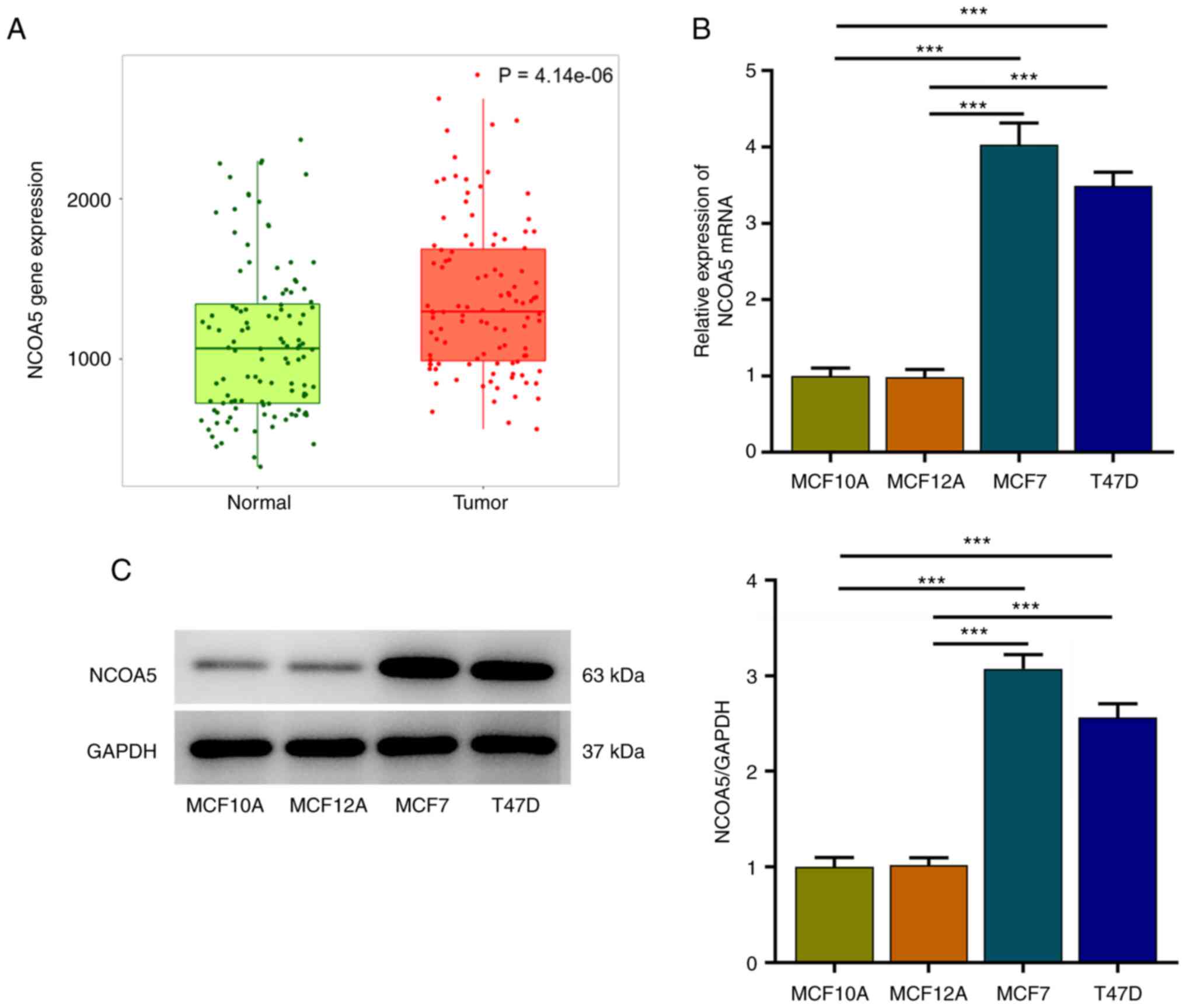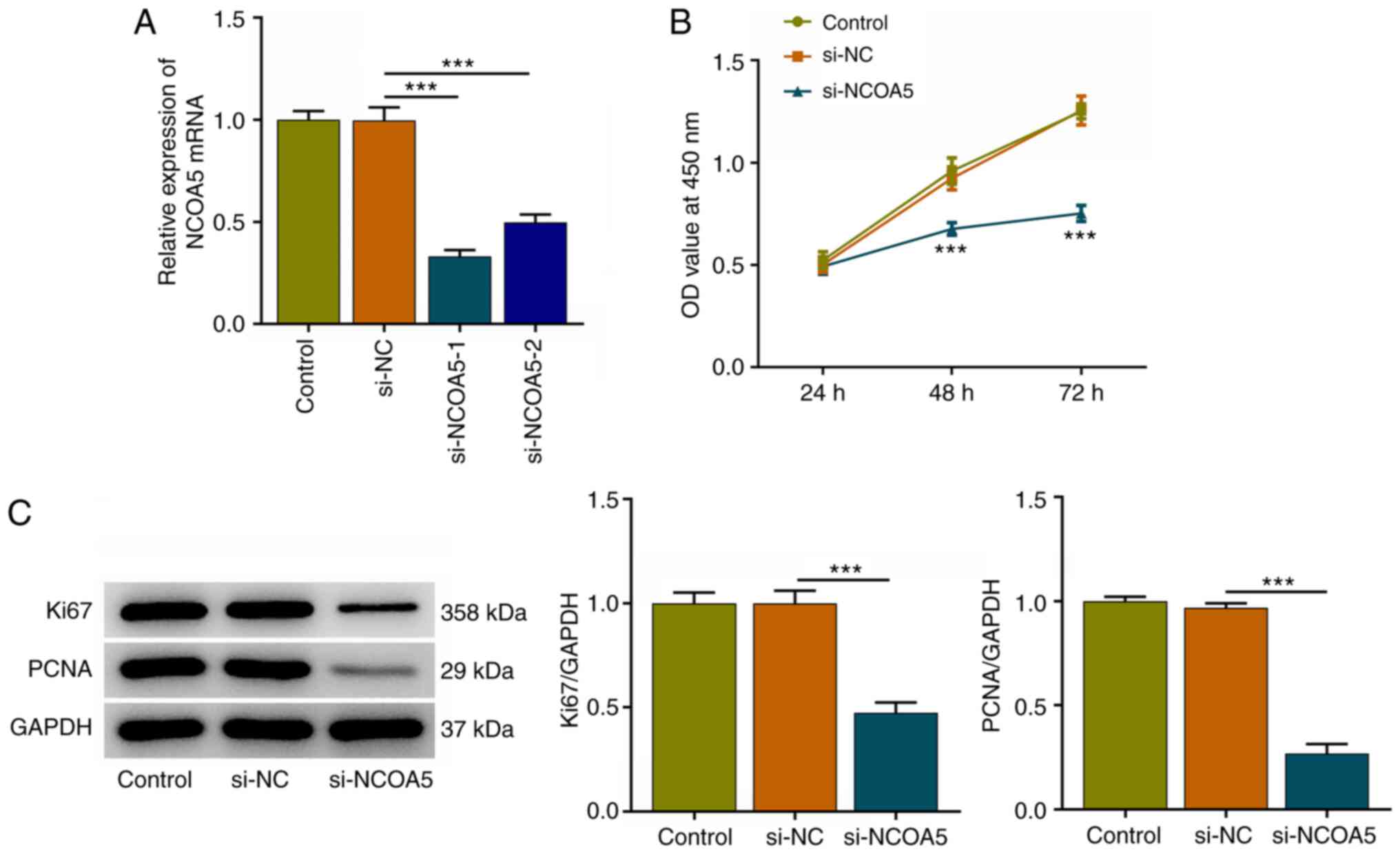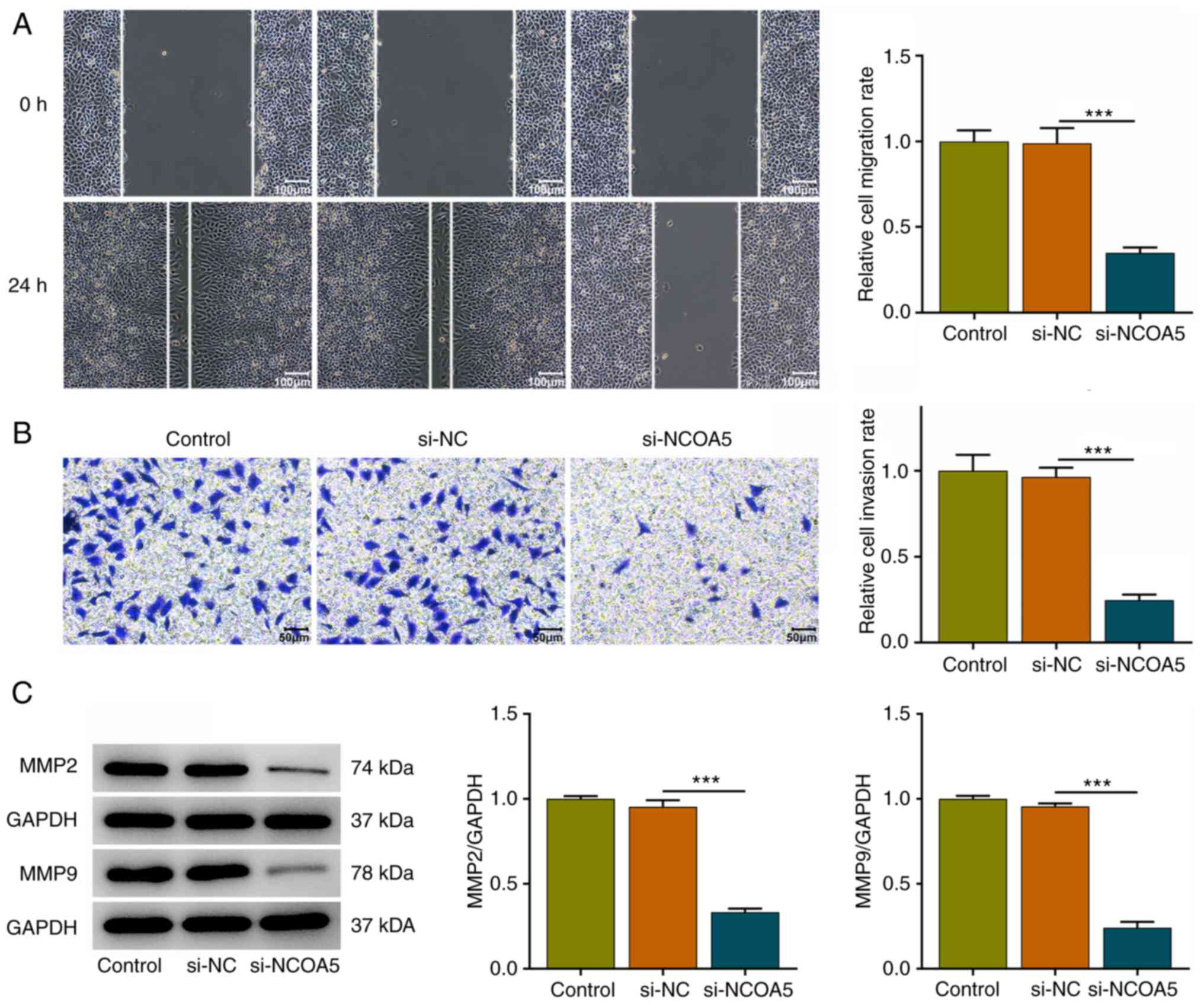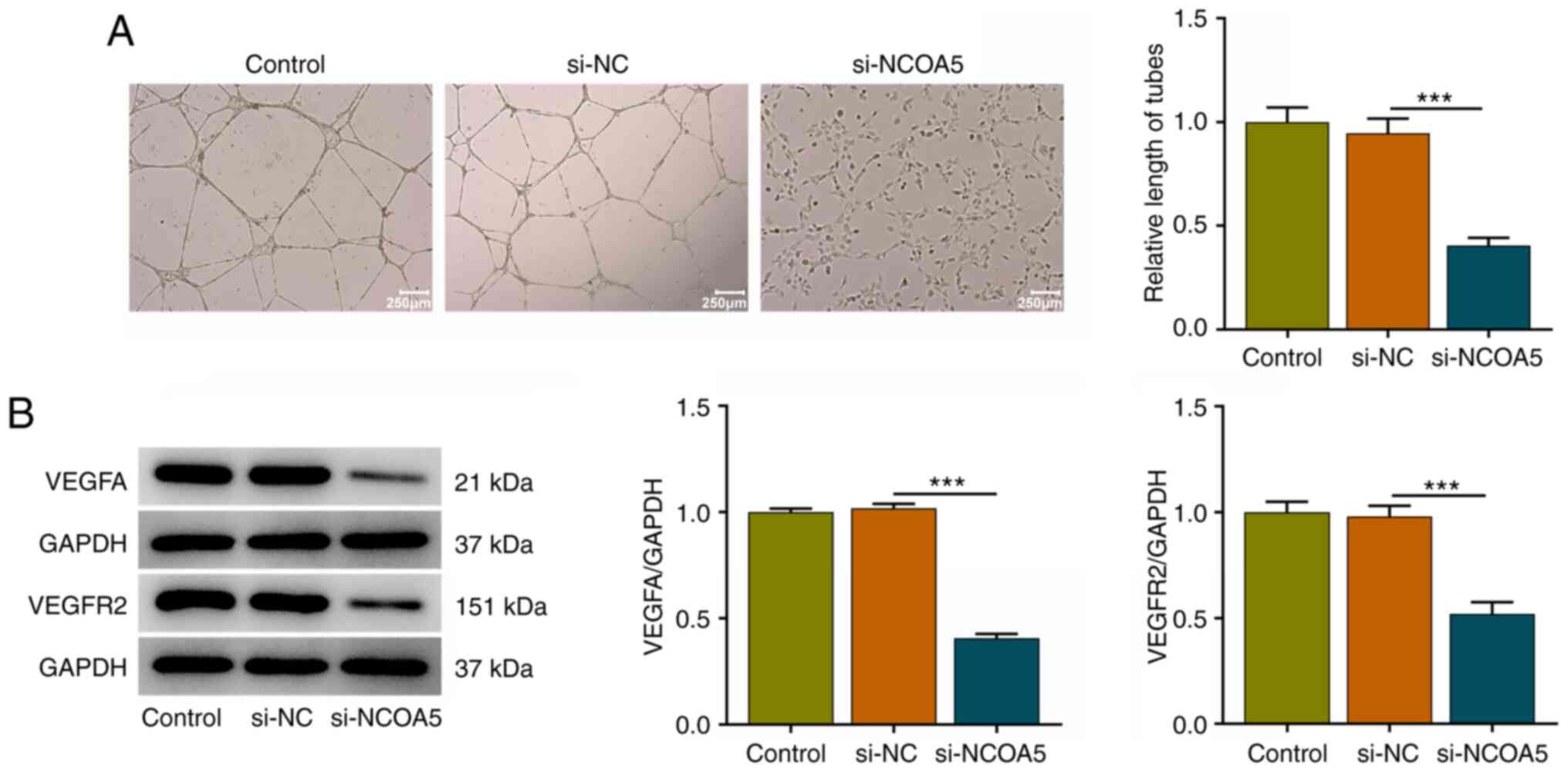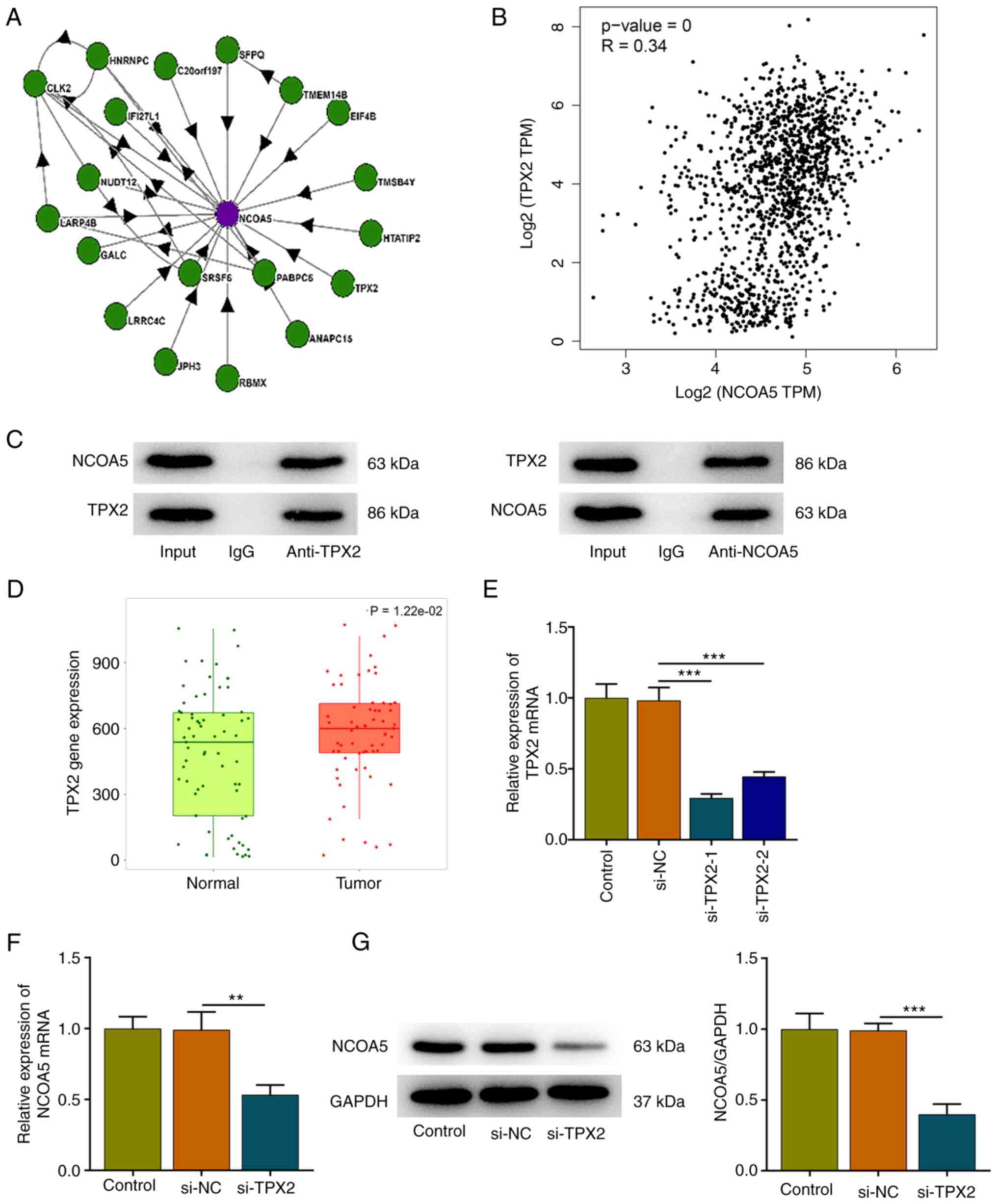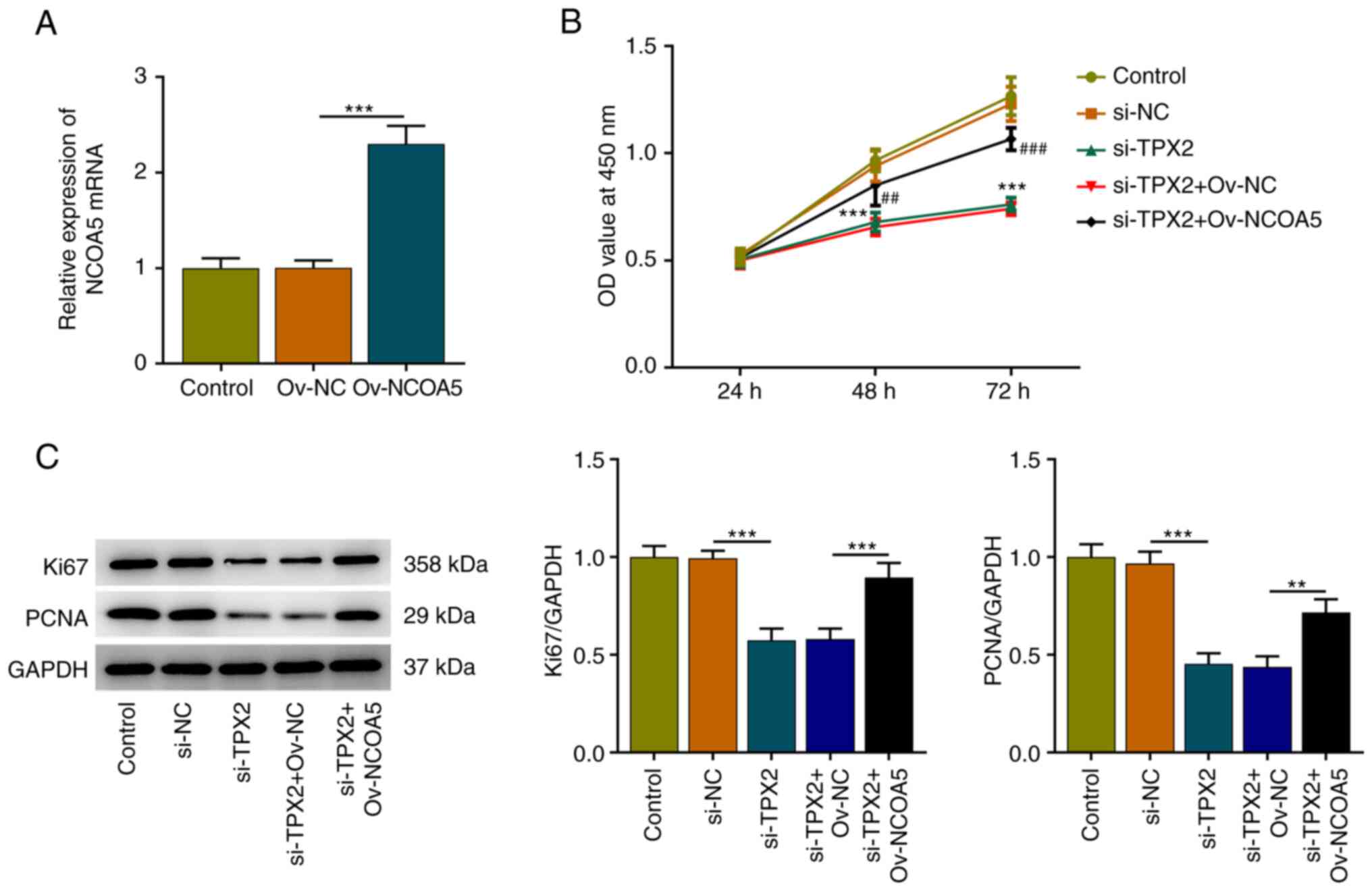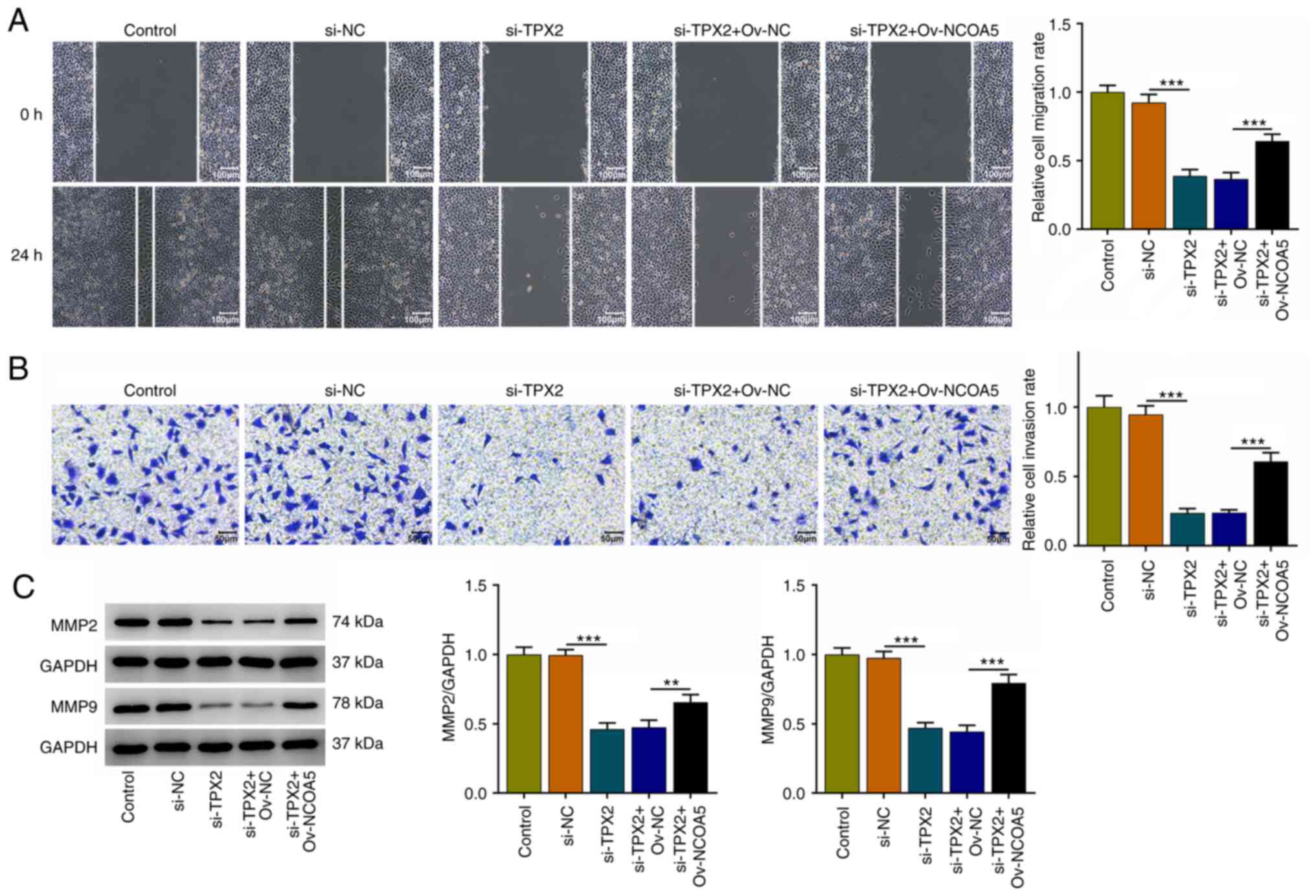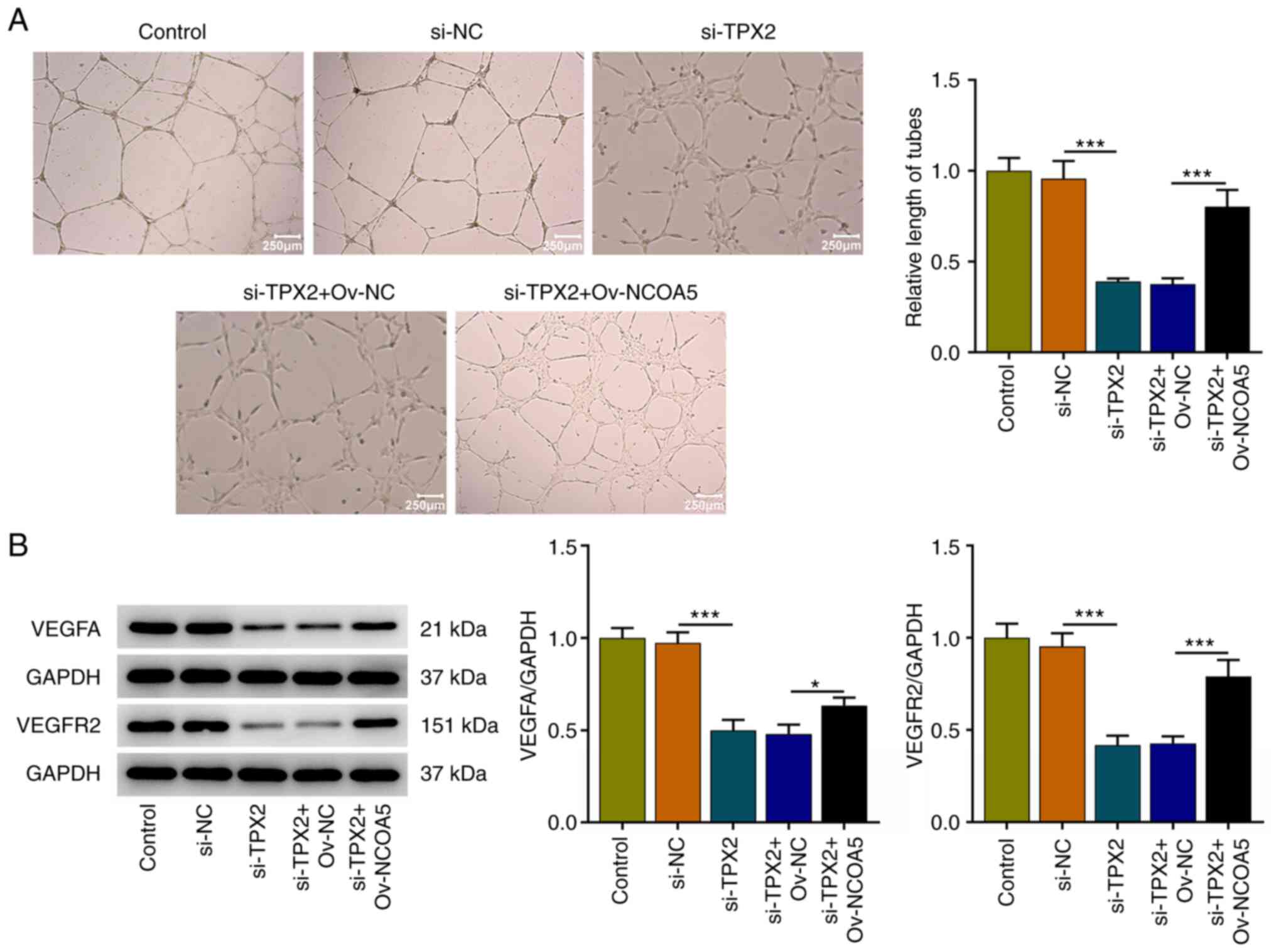Role of the TPX2/NCOA5 axis in regulating proliferation, migration, invasion and angiogenesis of breast cancer cells
- Authors:
- Published online on: May 9, 2023 https://doi.org/10.3892/etm.2023.12003
- Article Number: 304
-
Copyright: © Wang et al. This is an open access article distributed under the terms of Creative Commons Attribution License.
Abstract
Introduction
Breast cancer that occurs in women is a highly malignant tumor with poor prognosis. As reported in the Global Cancer Statistics 2020, breast cancer ranks first in cancer incidence (number: 2261419; percentage: 11.7%) and fifth in mortality (number: 684996; percentage: 6.9%) worldwide (1). Nowadays, surgery combined with radiotherapy, chemotherapy, endocrine therapy and targeted therapy is the main treatment for breast cancer (2). Despite the multiple treatment methods available, a large proportion of patients will eventually die of recurrence and metastasis of breast cancer (3,4). Hence, it seems imperative to elaborate the molecular mechanisms underlying the malignant progression of breast cancer and to develop effective therapeutic targets against breast cancer metastasis.
Nuclear receptor coactivator 5 (NCOA5), also known as coactivator independent of activation function-2(AF-2) domain (CIA), is a nuclear receptor coregulator (5). Recently, the abnormal expression of NCOA5 in tumor tissues has attracted considerable attention. Elevated NCOA5 in colorectal cancer is closely related to the malignant biological behaviors of cancer cells and prognosis of patients (6). Knockdown of NCOA5 can suppress hepatocellular carcinoma cell proliferation and migration (7). Moreover, it has been verified that NCOA5 is highly expressed in breast cancer tissues, and is lowly expressed in adjacent non-cancerous tissues, and NCOA5 is highly associated with the poor prognosis of breast cancer patients (8). Furthermore, NCOA5 was greatly correlated with lymph node metastasis in breast cancer, and its expression could predict the overall survival time, thus NCOA5 is considered as a promising novel management target for breast cancer (9), whereas its specific regulatory mechanism in the progression of breast cancer has not been fully elucidated till now.
Protein interactors of NCOA5 were predicted by querying the BioPlex database and BioPlex interaction data presented that targeting protein for xenopus kinesin-like protein 2 (TPX2) could interact with NCOA5. TPX2 is a micro-associated protein that associates with the formation and stability of the mitotic spindle (10). High expression of TPX2 in different human tissues can lead to disordered phenomena including abnormal amplification of centrosome, formation of aneuploidy, malignant cell transformation (10,11). Recent researches have reported that TPX2 is overexpressed in multiple malignancies and TPX2 expression is highly associated with the occurrence, development and prognosis of cancers (12,13). In addition, TPX2 expression is remarkably elevated in breast cancer tissues compared with adjacent non-cancerous tissues, and knockdown of TPX2 can suppress the proliferation, invasion and migration of breast cancer cells (14,15).
In general, the present work was formulated to elucidate the functions of NCOA5 in the malignant biological behaviors of breast cancer cells and to explore the molecular mechanisms underlying the involvement of TPX2/NCOA5 in the development of breast cancer.
Materials and methods
Cell culture
Human breast epithelial cell lines (MCF10A, MCF12A), human breast cancer cell lines (MCF7, T47D) and human immortalized umbilical vein endothelial cells (HUVEC/EAhy926) were obtained from American Type Culture Collection (ATCC). MCF10A and MCF12A cells were cultured in Dulbecco's modified Eagle's medium (DMEM)/F12 supplemented with 10% fetal bovine serum (FBS; Gibco; Thermo Fisher Scientific, Inc.) and 1% penicillin/streptomycin solution (Gibco; Thermo Fisher Scientific, Inc.). HUVECs, MCF7 and T47D cells were cultured in DMEM medium supplemented with 10% FBS and 1% penicillin/streptomycin solution. All cells were incubated at 37̊C in a humidified 5% CO2 atmosphere.
Cell transfection
Small interfering RNA (siRNA) plasmid targeting NCOA5 (si-NCOA5-1, si-NCOA5-2), siRNA plasmid targeting TPX2 (si-TPX2-1, si-TPX2-2) and empty siRNA plasmid (si-NC), NCOA5 overexpression plasmid (Ov-NCOA5) and the corresponding negative control (Ov-NC) were purchased from GenePharma. Transfection was conducted using Lipofectamine® 2000 (Invitrogen; Thermo Fisher Scientific, Inc.) according to the manufacturer's protocol. The NCOA5- and TPX2-specific siRNA sequences were listed as follows: si-NCOA5-1, 5'-GACTTGATCTTCCTTAACACAGA-3', si-NCOA5-2, 5'-TTCTCCTTTTGCTATTGTCATCA-3', si-TPX2-1, 5'-CACAAGTTAAAAGCTCTTATTCC-3', and si-TPX2-2, 5'-AAGTTAAAAGCTCTTATTCCTAT-3'.
TNMplot analysis
Expressions of NCOA5 and TPX2 between paired non-tumor and tumor tissues of breast cancer patients were compared using TNMplot website (http://tnmplot.com/analysis/). Mann Whitney was used for statistical test.
Cell counting kit-8 (CCK-8) assay
Cell viability was determined using CCK-8 assay. In short, MCF7 cells (5x103 cells/well) were inoculated into a 96-well plate and then incubated for 24, 48 or 72 h at 37̊C. Next, 10 µl CCK-8 reagent (Beyotime) was added into each well for another 4 h incubation. The optical density (OD450 nm) was measured using a microplate reader (Bio-Rad).
Wound healing assay
Cell migratory ability was evaluated using wound healing assay. The transfected or untransfected MCF7 cells (1x105 cells/well) were cultured in a 6-well plate and grown to 90% confluence. Then, the wounds were created by scratching the monolayer of cells with a sterile 200-µl pipette tip and the detached cells were washed twice with PBS. Next, MCF7 cells were incubated in fresh serum-free DMEM for 24 h. Images of the wounds were captured at 0 and 24 h under a light microscope (magnification, x100; Leica).
Transwell assay
Cell invasive ability was evaluated using transwell assay. The transfected or untransfected MCF7 cells were suspended in fresh serum-free DMEM. A total of 5x104 cells were seeded into the upper chamber of transwell plates pre-coated with matrigel (BD Biosciences) and 600 µl FBS-DMEM was added into the lower chamber as a chemoattractant. After 24 h incubation, non-invasive cells were gently removed and the invasive cells in the lower chamber were fixed in 4% paraformaldehyde and stained with 0.1% crystal violet solution. Stained cells were photographed and counted under a light microscope (magnification, x200; Leica).
Tube formation assay
In short, the conditioned media (CM) of MCF7 cells was collected. HUVECs (2x104 cells/well) were seeded into the 96-well plate pre-coated with Matrigel and then incubated with CM at 37˚C for 24 h. Tube formation was observed and photographed under a light microscope (magnification, x40; Leica, Wetzlar, Germany).
Reverse transcription-quantitative polymerase chain reaction (RT-qPCR)
Total RNA was extracted using TRIzol reagent (Invitrogen; Thermo Fisher Scientific, Inc.) in compliance with the manufacturer's standard procedures. RNA samples were reversely transcribed into cDNA using a PrimeScript RT kit (Takara). Subsequently, PCR reactions were performed on an ABI 7500 system (Applied Biosystems) using SYBR Premix Ex Taq kit (Takara). The PCR thermocycling conditions were as follows: Initial denaturation at 95˚C for 10 min; followed by 40 cycles of 95˚C for 15 sec and 64˚C for 30 sec. Primer sequences were as follows: NCOA5 forward: 5'-TGCTATTGTCATCACCCAG-3', reverse: 5'-CTCATTCTTGTAACGCTCATA-3'; TPX2 forward: 5'-ATGGAACTGGAGGGCTTTTTC-3', reverse: 5'-TGTTGTCAACTGGTTTCAAAGGT-3'; GAPDH forward: 5'-GGTCTCCTCTGACTTCAACA-3', reverse: 5'-GTGAGGGTCTCTCTCTTCCT-3'. GAPDH served as the endogenous control. The relative gene expression was calculated using 2-∆∆Ct method (16).
Western blot assay
Total proteins were extracted using RIPA lysis buffer (Beyotime) and protein concentration was determined using BCA Protein Assay Kit (Beyotime). Equal amounts of protein samples were separated by sodium dodecyl sulphate-polyacrylamide gel electrophoresis (SDS-PAGE) and then transferred onto polyvinylidene difluoride (PVDF) membranes (Millipore). Nonspecific binding proteins were blocked with 5% non-fat milk for 1.5 h at room temperature. Subsequently, membranes were incubated overnight at 4̊C with antibodies against NCOA5 (Bioworld, BS67243, 1:1,000), Ki67 (Abcam, ab16667, 1:1,000), PCNA (Abcam, ab92552, 1:1,000), MMP2 (Abcam, ab92536, 1:1,000), MMP9 (Abcam, ab76003, 1:1,000), VEGFA (Thermo Fisher Scientific, OPA1-10110, 1:200), VEGFR2 (Abcam, ab134191, 1:1,000), TPX2 (Abcam, ab252945, 1:1,000) and GAPDH (Abcam, ab9485, 1:2,500). On the next day, membranes were incubated with horseradish peroxidase (HRP)-conjugated secondary antibody (Abcam, ab6721, 1:3,000) for 2 h at room temperature. GAPDH served as the endogenous control. Enhanced chemiluminescence (ECL) kit was applied to develop the protein bands and the blots were visualized and analyzed by a Bio-Rad imaging system (Bio-Rad).
BioPlex network analysis
The general biological repository for interaction data sets (https://bioplex.hms.harvard.edu/) was adopted to explore the BioPlex interaction data and identify high-confidence NCOA5 interactors.
Gene Expression Profiling Interactive Analysis (GEPIA)
GEPIA (http://gepia.cancer-pku.cn) is a web-based data mining platform with large RNA sequencing data from TCGA and GTEx. Gene expression correlation analysis was performed in the ‘Correlation’ module. The correlation coefficient was conducted by Pearson's correlation test.
Co-immunoprecipitation (Co-IP)
The interaction between NCOA5 and TPX2 was validated by employing Co-IP assay. Cells were lysed on ice for 30 min using cell lysis buffer consisting of complete protease inhibitor. Then, anti-NCOA5, anti-TPX2 or control IgG were added into the collected supernatant of cell lysates and incubated for 12 h at 4̊C. Next, 20 µl of protein A/G agarose beads (Santa Cruz Biotechnology, Inc.) were added to the mixture and incubated overnight at 4̊C. The pelleted resin was washed three times by washing buffer and the immuno-complexes were subjected to western blot analysis.
Statistical analysis
Data of three independent experiments were expressed as means ± SD. Comparisons among multiple groups were carried out using one-way analysis of variance (ANOVA) followed by Tukey's post hoc test. *P<0.05 represented a statistically significant difference.
Results
NCOA5 is highly expressed in breast cancer
TNMplot was adopted to analyze NCOA5 expression in paired non-tumor and tumor tissues of breast cancer patients. NCOA5 expression was markedly elevated in tumor tissues compared to the adjacent non-tumor tissues (Fig. 1A). Besides, expression differences of NCOA5 in human breast epithelial cell lines (MCF10A, MCF12A) and human breast cancer cell lines (MCF7, T47D) were assessed via RT-qPCR and western blot assay. In comparison with those in MCF10A and MCF12A cells, NCOA5 mRNA (Fig. 1B) and protein (Fig. 1C) levels in MCF7 and T47D cells were significantly increased, especially in MCF7 cells. Thus, MCF7 cells were selected for the follow-up experiments.
NCOA5 knockdown suppresses the proliferation of breast cancer cells
In the current work, MCF7 cells were transfected with si-NCOA5-1/2 or si-NC and transfection efficiency was validated via RT-qPCR. NCOA5 expression was markedly downregulated following transfection with si-NCOA5-1/2. Attributed a relative high transfection efficacy, si-NCOA5-1 was selected for subsequent research (Fig. 2A). Results of CCK-8 assay indicated that NCOA5 knockdown inhibited the viability of MCF7 cells (Fig. 2B). Additionally, decreased expressions of proliferation markers (Ki67 and PCNA) following NCOA5 knockdown in MCF7 cells also demonstrated that downregulation of NCOA5 could inhibit the proliferation of breast cancer cells (Fig. 2C).
NCOA5 knockdown restrains the migration and invasion of breast cancer cells
In addition, wound healing and transwell assays were conducted to explore whether NCOA5 was functionally involved in the migration and invasion of breast cancer cells. It was verified that NCOA5 knockdown obviously repressed the migratory and invasive abilities of MCF7 cells (Fig. 3A and B). Besides, decreases in MMP2 and MMP9 expressions following NCOA5 knockdown also suggested that downregulation of NCOA5 could suppress the migration and invasion of breast cancer cells (Fig. 3C).
NCOA5 knockdown induces weaker in vitro angiogenesis
Angiogenesis is a fundamental characteristic of tumors. Tumor growth and metastasis need glorious angiogenesis for nutrition provision. Vascular endothelial cell migration and tube formation are important processes in tumor-related abnormal angiogenesis. A tube formation assay of HUVECs revealed that downregulation of NCOA5 induced a weaker in vitro angiogenesis (Fig. 4A). Meanwhile, decreased expressions of VEGFA and VEGFR2 in HUVECs together demonstrated that NCOA5 was causally associated with in vitro angiogenesis and NCOA5 knockdown could restrain in vitro angiogenesis (Fig. 4B).
TPX2 interacts with NCOA5
High-confidence NCOA5 interactors were identified based on BioPlex network data sets (Fig. 5A). Then, the correlation expression of NCOA5 and TPX2 was analyzed by the Correlation Analysis module of GEPIA. NCOA5 was moderately correlated with TPX2 in breast cancer (Fig. 5B). Furthermore, the interaction between TPX2 and NCOA5 was validated by employing Co-IP assay. NCOA5 protein existed in the anti-TPX2 group and TPX2 protein existed in the anti-NCOA5 group, suggesting that TPX2 and NCOA5 could interact with each other (Fig. 5C). In addition, TNMplot presented that TPX2 expression was markedly elevated in tumor tissues of breast cancer patients in comparison with that in the adjacent non-tumor tissues (Fig. 5D). Then, MCF7 cells were transfected with si-TPX2 or si-NC. TPX2 expression was markedly downregulated following transfection and si-TPX2-1 with a relatively high transfection efficiency was selected for subsequent research (Fig. 5E). It was observed that TPX2 knockdown downregulated NCOA5 expression, indicating a positive correlation between TPX2 and NCOA5 expression in breast cancer cells (Fig. 5F and G).
TPX2 knockdown suppresses the proliferation of breast cancer cells by downregulating NCOA5
Subsequently, Ov-NCOA5 was introduced into MCF7 cells for rescue experiments, aiming to investigate whether TPX2 mediated the malignant biological behaviors of breast cancer cells by regulating NCOA5 expression. Transfection efficiency was validated via RT-qPCR and transfection of Ov-NCOA5 markedly upregulated NCOA5 expression (Fig. 6A). Results of CCK-8 assay indicated that TPX2 knockdown inhibited the viability of MCF7 cells, which was reversed by NCOA5 overexpression (Fig. 6B). Additionally, increased expressions of Ki67 and PCNA in MCF7 cells also demonstrated that upregulation of NCOA5 reversed the suppressive effect of TPX2 knockdown on the proliferation of breast cancer cells (Fig. 6C). In a word, these evidences implied that TPX2 knockdown could inhibit the proliferative capacity of breast cancer cells by downregulating NCOA5 expression.
TPX2 knockdown restrains the migration and invasion of breast cancer cells by downregulating NCOA5
Moreover, it was discovered that TPX2 knockdown suppressed the migratory and invasive capabilities of MCF7 cells, which were reversed by NCOA5 overexpression (Fig. 7A and B). Besides, increases in MMP2 and MMP9 expressions also suggested that upregulation of NCOA5 reversed the suppressive effects of TPX2 knockdown on the migration and invasion of breast cancer cells (Fig. 7C). To conclude, TPX2 knockdown could repress the migratory and invasive capacities of breast cancer cells by downregulating NCOA5 expression.
TPX2 knockdown induces weaker in vitro angiogenesis by downregulating NCOA5
The tube formation assay of HUVECs revealed that TPX2 knockdown induced a weaker in vitro angiogenesis, which were reversed by NCOA5 overexpression (Fig. 8A). Meanwhile, increased expressions of VEGFA and VEGFR2 in HUVECs together demonstrated that upregulation of NCOA5 reversed the suppressive effect of TPX2 knockdown on in vitro angiogenesis (Fig. 8B). Overall, TPX2 knockdown could arrest in vitro angiogenesis by downregulating NCOA5 expression.
Discussion
Breast cancer is one of the most common malignant tumors in women worldwide. Although systemic therapies have improved the prognosis of breast cancer patients, recurrence and metastasis are barriers to the successful treatment of patients with breast cancer (17). Meanwhile, understanding of the pathogenesis and mechanisms of breast cancer remains greatly limited. Recently, early diagnosis and molecular targeted therapy for breast cancer patients have become research hotspots (18). Therefore, it is in urgent need to identify new genes involved in breast cancer, aiming to aid the development of faster and safer diagnostic methods and to improve breast cancer prognosis and treatment.
Evidences suggest that NCOA5 is highly expressed in colorectal cancer (6), hepatocellular carcinoma (7) and breast cancer (8) tissues or cell lines. Interestingly, Tan et al (19) have reported that NCOA5 is upregulated in breast cancer tissues and cell lines, and NCOA5 knockdown could inhibit the viability, migration and epithelial-mesenchymal transition (EMT) of breast cancer cell lines. Likewise, our current research also demonstrated that NCOA5 expression was significantly elevated in breast cancer and downregulation of NCOA5 suppressed the proliferative, migratory and invasive capabilities of breast cancer cells. Tumor neovascularization is one of the main characteristics of tumors (20). It plays an important role in the rapid proliferation of tumor cells and metastasis to distant places (21). In breast, cancer angiogenesis has been evidenced to be a promising therapeutic target. For example, Zhang et al (22) demonstrated that angiotensin-converting enzyme 2 (ACE2) could restrain the progression of breast cancer through inhibiting angiogenesis; Cao et al (23) discovered decylubiquinone to repress breast cancer growth and metastasis via restricting angiogenesis. In current research, it was confirmed that tube formation capacity of HUVECs was arrested by NCOA5 knockdown, suggesting that downregulation of NCOA5 could inhibit in vitro angiogenesis. Therefore, NCOA5 knockdown may exert tumor-suppressive effect via inhibiting cell proliferation, migration, invasion and angiogenesis in breast cancer.
TPX2 was identified as a high-confidence NCOA5 interactor based on BioPlex network data sets. Furthermore, our work validated the interaction between TPX2 and NCOA5 by employing Co-IP assay. TPX2 interacted with NCOA5 and there was a positive correlation between TPX2 and NCOA5 expression. Abnormal cell cycle mitosis is an important factor leading to tumorigenesis and growth (11). TPX2 participates in the assembly and stability of the spindle, which is a vital key to the regulation of mitosis (10). Nowadays, abundant studies have focused on the aberrant TPX2 expression in tumors and its targeted inhibition (12,13). Zhou et al (24) have proposed that TPX2 overexpression could promote migration, invasion, EMT and activities of MMPs of non-small cell lung cancer cells. In addition, TPX2 has been proved to function as a tumor promoter in breast cancer (14,15). Consistently, in our study, it was also confirmed that TPX2 was highly expressed in breast cancer, and the following experiments revealed that TPX2 knockdown suppressed the proliferative, migratory and invasive capabilities of breast cancer cells as well as inhibited in vitro angiogenesis, suggesting that TPX2 knockdown was beneficial to restricting breast cancer development, and TPX2 might be an alternative target for treatment strategies. Furthermore, the rescue experiments revealed that upregulation of NCOA5 reversed the suppressive effects of TPX2 knockdown on proliferation, migration, invasion of breast cancer cells and in vitro angiogenesis, further emphasizing the TPX2/NCOA5 axis in regulating the development of breast cancer.
However, there were some limitations in this study. First, all data were obtained from one single cell line, and more cell lines might be beneficial to verify our conclusion; Secondly, although the aberrant expression level of NCOA5 and TPX2 has been reported in the human breast cancer tumor samples in previous documents (14,19), the clinical validation in this study is still helpful to improve the manuscript quality, which is now planned in our future research.
To sum up, downregulation of TPX2 repressed proliferation, migration and invasion of breast cancer cells as well as restrained in vitro angiogenesis via suppressing NCOA5 expression. Findings may prompt that NCOA5 is a downstream target of TPX2 in enhancing cell proliferation, migration, invasion and angiogenesis of breast cancer.
Acknowledgements
Not applicable.
Funding
Funding: No funding was received.
Availability of data and materials
The datasets used and/or analyzed during the current study are available from the corresponding author on reasonable request.
Authors' contributions
TW, FZ and PZ searched the literature, designed the study, performed the experiments, analyzed and interpreted the data, and wrote the manuscript. TW and PZ confirm the authenticity of all the raw data. All authors have read and approved the final manuscript.
Ethics approval and consent to participate
Not applicable.
Patient consent for publication
Not applicable.
Competing interests
The authors declare that they have no competing interests.
References
|
Sung H, Ferlay J, Siegel RL, Laversanne M, Soerjomataram I, Jemal A and Bray F: Global cancer statistics 2020: GLOBOCAN estimates of incidence and mortality worldwide for 36 cancers in 185 countries. CA Cancer J Clin. 71:209–249. 2021.PubMed/NCBI View Article : Google Scholar | |
|
DeSantis CE, Ma J, Gaudet MM, Newman LA, Miller KD, Goding Sauer A, Jemal A and Siegel RL: Breast cancer statistics, 2019. CA Cancer J Clin. 69:438–451. 2019.PubMed/NCBI View Article : Google Scholar | |
|
Henriques B, Mendes F and Martins D: Immunotherapy in breast cancer: When, how, and what challenges. Biomedicines. 9(1687)2021.PubMed/NCBI View Article : Google Scholar | |
|
Liang Y, Zhang H, Song X and Yang Q: Metastatic heterogeneity of breast cancer: Molecular mechanism and potential therapeutic targets. Semin Cancer Biol. 60:14–27. 2020.PubMed/NCBI View Article : Google Scholar | |
|
Chen GQ, Tian H, Yue WM, Li L, Li SH, Qi L, Gao C, Si LB and Lu M: NCOA5 low expression correlates with survival in esophageal squamous cell carcinoma. Med Oncol. 31(376)2014.PubMed/NCBI View Article : Google Scholar | |
|
Sun K, Wang S, He J, Xie Y, He Y, Wang Z and Qin L: NCOA5 promotes proliferation, migration and invasion of colorectal cancer cells via activation of PI3K/AKT pathway. Oncotarget. 8:107932–107946. 2017.PubMed/NCBI View Article : Google Scholar | |
|
He J, Zhang W, Li A, Chen F and Luo R: Knockout of NCOA5 impairs proliferation and migration of hepatocellular carcinoma cells by suppressing epithelial-to-mesenchymal transition. Biochem Biophys Res Commun. 500:177–183. 2018.PubMed/NCBI View Article : Google Scholar | |
|
Ye XH, Huang DP and Luo RC: NCOA5 is correlated with progression and prognosis in luminal breast cancer. Biochem Biophys Res Commun. 482:253–256. 2017.PubMed/NCBI View Article : Google Scholar | |
|
Xia E, Hu W, Bhandari A, Sindan N and Huang D: Nuclear receptor coactivator 5 is correlated with progression in breast carcinoma. Anticancer Agents Med Chem. 21:2520–2524. 2021.PubMed/NCBI View Article : Google Scholar | |
|
Safari MS, King MR, Brangwynne CP and Petry S: Interaction of spindle assembly factor TPX2 with importins-α/β inhibits protein phase separation. J Biol Chem. 297(100998)2021.PubMed/NCBI View Article : Google Scholar | |
|
Gomes-Filho SM, Dos Santos EO, Bertoldi ERM, Scalabrini LC, Heidrich V, Dazzani B, Levantini E, Reis EM and Bassères DS: Aurora A kinase and its activator TPX2 are potential therapeutic targets in KRAS-induced pancreatic cancer. Cell Oncol (Dordr). 43:445–460. 2020.PubMed/NCBI View Article : Google Scholar | |
|
Zhang B, Zhang M, Li Q, Yang Y, Shang Z and Luo J: TPX2 mediates prostate cancer epithelial-mesenchymal transition through CDK1 regulated phosphorylation of ERK/GSK3β/SNAIL pathway. Biochem Biophys Res Commun. 546:1–6. 2021.PubMed/NCBI View Article : Google Scholar | |
|
Zhu H, Liu J, Feng J, Zhang Q, Bian T, Li X, Sun H, Zhang J and Liu Y: Overexpression of TPX2 predicts poor clinical outcome and is associated with immune infiltration in hepatic cell cancer. Medicine (Baltimore). 99(e23554)2020.PubMed/NCBI View Article : Google Scholar | |
|
Yang Y, Li DP, Shen N, Yu XC, Li JB, Song Q and Zhang JH: TPX2 promotes migration and invasion of human breast cancer cells. Asian Pac J Trop Med. 8:1064–1070. 2015.PubMed/NCBI View Article : Google Scholar | |
|
Jiang Y, Liu Y, Tan X, Yu S and Luo J: TPX2 as a novel prognostic indicator and promising therapeutic target in triple-negative breast cancer. Clin Breast Cancer. 19:450–455. 2019.PubMed/NCBI View Article : Google Scholar | |
|
Livak KJ and Schmittgen TD: Analysis of relative gene expression data using real-time quantitative PCR and the 2(-Delta Delta C(T)) method. Methods. 25:402–408. 2001.PubMed/NCBI View Article : Google Scholar | |
|
Kumar S, Srivastav RK, Wilkes DW, Ross T, Kim S, Kowalski J, Chatla S, Zhang Q, Nayak A, Guha M, et al: Estrogen-dependent DLL1-mediated notch signaling promotes luminal breast cancer. Oncogene. 38:2092–2107. 2019.PubMed/NCBI View Article : Google Scholar | |
|
Zhang Y, Shu C, Maimaiti Y, Wang S, Lu C and Zhou J: LRP6 as a biomarker of poor prognosis of breast cancer. Gland Surg. 10:2414–2427. 2021.PubMed/NCBI View Article : Google Scholar | |
|
Tan Y, Liu F and Xu P: Knockdown of NCOA5 suppresses viability, migration and epithelial-mesenchymal transition, and induces adhesion of breast cancer cells. Oncol Lett. 22(694)2021.PubMed/NCBI View Article : Google Scholar | |
|
Chen WZ, Jiang JX, Yu XY, Xia WJ, Yu PX, Wang K, Zhao ZY and Chen ZG: Endothelial cells in colorectal cancer. World J Gastrointest Oncol. 11:946–956. 2019.PubMed/NCBI View Article : Google Scholar | |
|
Tu J, Fang Y, Han D, Tan X, Jiang H, Gong X, Wang X, Hong W and Wei W: Activation of nuclear factor-κB in the angiogenesis of glioma: Insights into the associated molecular mechanisms and targeted therapies. Cell Prolif. 54(e12929)2021.PubMed/NCBI View Article : Google Scholar | |
|
Zhang Q, Lu S, Li T, Yu L, Zhang Y, Zeng H, Qian X, Bi J and Lin Y: ACE2 inhibits breast cancer angiogenesis via suppressing the VEGFa/VEGFR2/ERK pathway. J Exp Clin Cancer Res. 38(173)2019.PubMed/NCBI View Article : Google Scholar | |
|
Cao J, Liu X, Yang Y, Wei B, Li Q, Mao G, He Y, Li Y, Zheng L, Zhang Q, et al: Decylubiquinone suppresses breast cancer growth and metastasis by inhibiting angiogenesis via the ROS/p53/BAI1 signaling pathway. Angiogenesis. 23:325–338. 2020.PubMed/NCBI View Article : Google Scholar | |
|
Zhou F, Wang M, Aibaidula M, Zhang Z, Aihemaiti A, Aili R, Chen H, Dong S, Wei W and Maimaitiaili A: TPX2 promotes metastasis and serves as a marker of poor prognosis in non-small cell lung cancer. Med Sci Monit. 26(e925147)2020.PubMed/NCBI View Article : Google Scholar |



